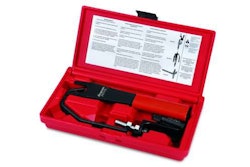 T-connectors and combo trailer plugs make easy work of damaged trailer wiring connections
T-connectors and combo trailer plugs make easy work of damaged trailer wiring connections
By John Tiger
Everyone who has ever towed a trailer on a regular basis has a trailer light “tale of woe” story or two. Wiring and lighting issues are commonplace around any business where trailers are used hard and towed behind pickups.
That’s because the factory trailer wiring components are mounted close to or attached to the hitch receiver, which also means they are in an area that tends to receive maximum abuse.
The good news is the damaged wiring components on most post-2000 work trucks are easily replaced with aftermarket “T”-connect harnesses, saving time and money in shop labor and downtime. One simply removes the OEM wiring harness under the rear bumper and plugs in the new one.
THE NEW T’s
Little has changed fundamentally in the way of wiring pickups for towing since about 2003 or so, and aftermarket replacement T-harnesses line the shelves at every auto parts store.
 The most popular connectors are the standard 7-Way “RV”-style blade terminal connector and the combination 7-way/flat-4 connector.
The most popular connectors are the standard 7-Way “RV”-style blade terminal connector and the combination 7-way/flat-4 connector.
Combo trailer plug setups are very popular among contractors and landscapers because the setup allows multiple types of trailers to be towed by the same truck.
The 7-way round “RV” connector is the most common with larger trailers that have electric brakes instead of surge-type brakes.
The common flat-4 connector is typically seen on lighter trailers surge-type brakes, such as boat trailers, smaller snowmobile and jet-ski trailers, small pop-up camper trailers and lighter utility trailers.
By the way, most states have towing laws that stipulate that trailer brakes (separate from tow vehicle brakes) are mandatory when the trailered weight exceeds a certain weight limit. That limit is commonly 3,000 pounds, although in New York it’s 1,000 pounds and in Texas 4,500 pounds.
MAKING THE JOB EASIER
Since most pickups come wired for towing from the factory, many of the aftermarket products come into play only for repair or adaptation, such as upgrading to a 5th wheel or gooseneck setup.
 Many factory connectors can quickly become damaged and/or corroded after a year or so of use, particularly in winter climates. In these cases, an aftermarket connector can repair the problem quickly at much less expense than going back to the dealer for a factory part.
Many factory connectors can quickly become damaged and/or corroded after a year or so of use, particularly in winter climates. In these cases, an aftermarket connector can repair the problem quickly at much less expense than going back to the dealer for a factory part.
Sometimes the aftermarket part is even better such as when a factory 7-way connector is replaced with an aftermarket 7/4-way combo connector like those offered by Tow Ready.
In other cases, the factory connector bracket rusts away or becomes deformed after backing into too many trailer tongues, dirt berms or snowbanks. Aftermarket replacement brackets are available that bolt to the hitch itself, so that no drilling or welding to the hitch or bumper is needed.
AUXILIARY HOOKUPS
For 5th wheel or gooseneck, the latest in convenience is the 5th Wheel/Gooseneck adapter, which is a simple wiring harness with factory 7-way connections that plug in underneath the bumper, and then a long 7-way wiring harness that threads up into the bed of the pickup.
The end point is another 7-way RV style blade connector with a 90-degree angle wiring harness that allows for a tighter mounting area.
Most installers mount these in the bed of the pickup, close to the 5th wheel or gooseneck hitch, so that the user only has to hook up the trailer to the hitch then plug the trailer’s 7-way harness into the bed-mounted 7-way receptacle.
Meanwhile, an identical 7-way receptacle under the bumper remains completely usable when towing a trailer behind the receiver hitch.
With very little installation difficulty and off-the-shelf connector harnesses, the same truck can adapt to pulling gooseneck/5th wheel trailers as well as receiver-pull trailers.
THE SUV CONNECTION
Though most pickups come equipped for towing, SUVs and crossover vehicles (CUVs) require a bit more attention. Some come equipped for towing with a hitch and wiring connector, just like pickups.
But the majority of SUVs and CUVs don’t come equipped for towing and require a vehicle specific T-connector that plugs into the taillight connector coupled with a factory-like wiring harness.
Usually, the connections are made right behind the tow vehicle’s taillights, which are usually removed to gain access.
That’s not the tough part, however. Usually, these T-connectors also include a powered, circuit-protected converter. This converter must be secured to the vehicle, usually behind an interior panel in the rear cargo area of the car.
The converter is then wired directly to the tow vehicle battery, using a large wire that must be run up under the chassis and to the battery (away from mufflers, pipes and moving parts of course). It’s fused right before the battery connection with a (supplied) 10-gauge automotive blade fuse.
This direct-wire method is done to isolate the trailer lights from the tow vehicle’s computer system and wiring.
When wired this way, the power to run the trailer lights is taken directly from the battery, not through the car’s wiring system.
This way, the trailer lights are brighter, the turn signals blink at the proper speed, and most important—the car’s computer and wiring don’t “see” the trailer lights, so there’s no danger of frying the wiring and computer.
SOURCES
B&W Hitch: 800-810-4918; www.turnoverball.com
Curt Manufacturing: 877-CURTMFG (287-8634); www.curtmfg.com
Cequent Performance Products: 800-632-3290; www.draw-tite.com
Hopkins Manufacturing: 800-524-1458; www.hopkinsmfg.com
Husky Towing Products: 800-495-5858; www.huskytow.com
T.E.S. (Towing Electrical Systems): 888-872-6281; www.testeam.com













